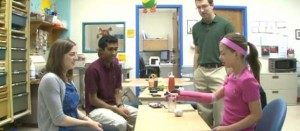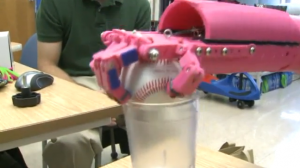by Bob Larson
 In 2013, I discussed how 3D printing has changed the medical industry. I recently noticed another application of 3D printing after reading this WebMD article. Sydney Kendall from Chesterfield, Missouri lost her right arm below the elbow in a boating accident when she was six years old.
In 2013, I discussed how 3D printing has changed the medical industry. I recently noticed another application of 3D printing after reading this WebMD article. Sydney Kendall from Chesterfield, Missouri lost her right arm below the elbow in a boating accident when she was six years old.
Now at 13, Sydney has used several prosthetic arms, but none of these were more practical or cool as her new pink, plastic, 3-D-printed robotic arm as shown here. The robotic arm with its opposing thumb and four fingers was designed by several Washington University St. Louis students. It helps Sydney grip a baseball, maneuver a computer mouse, and pick up a paper coffee cup.
The cost? About $200. Traditional customized robotic limbs can run $20,000 to $70,000. They need to be replaced as children grow. Robotic arms like Sydney’s are just one example of how 3-D printing is ushering in a new era in personalized medicine.
So what Is 3-D Printing? Imagine a printer spraying a plastic or metal gel or powder in the shape of a tooth, finger, or a hip joint. 3-D printers take their commands from either an MRI, CT scan, or CAD software program of a body part. Also known as “additive manufacturing,” 3-D printing produces an object, layer by layer, from the ground up.
The technique gives amputees like Sydney an alternative to more expensive prosthetics. For several years, Robohand, other labs, and private experimenters have been creating inexpensive and beneficial robotics using 3D printing technology!
~ Bob Larson is a technologist and Marketing Director for 50 Plus Media Solutions. Contact Bob at Marketing@50plusmediasolutions.com

